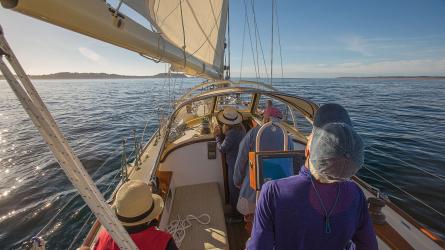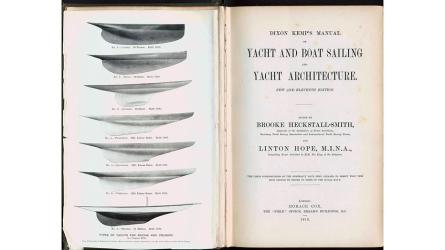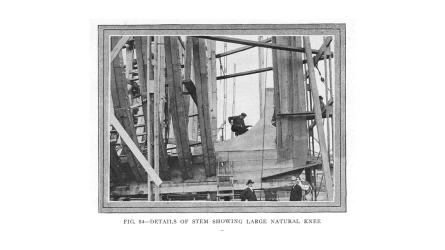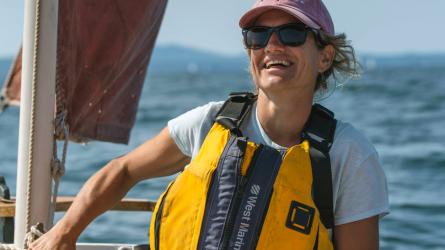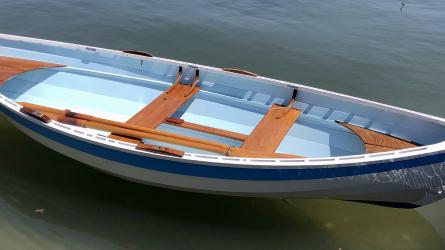MAYFLOWER II’s Rebirth
The replica ship as historic artifact
The replica ship as historic artifact

MATTHEW OTTO
Among the dramatic changes during the MAYFLOWER II reconstruction has been the complete replacement of her rigging, reducing weight aloft by about one-third. The standing rigging is of Mystic Three Strand, made by New England Rope.
Through the ages, stories are written and rewritten. Just as a prism shifted to change its angle of incidence scatters a slightly different spectrum on a new surface, so stories can subtly alter over time in each generation’s retelling. One story now being retold for a new generation is that of a ship—MAYFLOWER II, one of the most prominent “replicas,” or reproduction ships, in the United States.
In 1957, the ship completed its one great voyage, across the Atlantic from Plymouth, England, to Plymouth, Massachusetts, with none other than the great square-rig sailor and historian Alan Villiers in command. An expression of gratitude from the English people to the Americans after World War II, she retraced the wake of the famous 1620 Pilgrim voyage and was turned over to Plimoth Plantation. Plimoth, which opened in 1947, was one of a then-new and now-venerable constellation of living-history institutions that included Colonial Williamsburg, Virginia, opened in 1926; Mystic Seaport Museum in Connecticut, in 1931; Sturbridge Village, Massachusetts, in 1946; and Jamestown Settlement, Virginia, in 1957.

JAMES BARTICK
About 70 percent of the original hull timbers, including almost all hanging and lodging knees, many deckbeams, and all planking, have been replaced during the ship’s multi-year reconstruction at the Henry B. duPont Preservation Shipyard at Mystic Seaport, Connecticut.
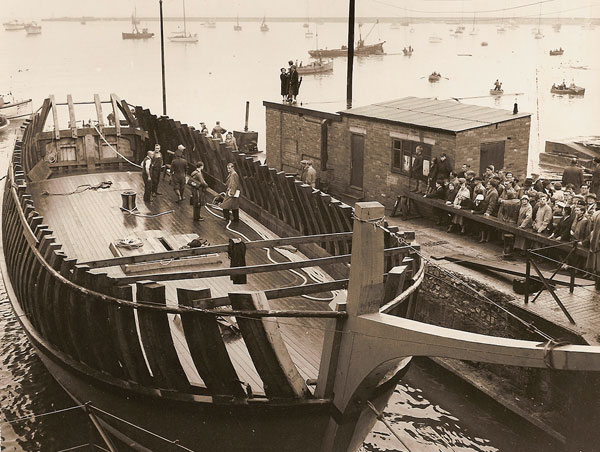
PLIMOTH PLANTATION
MAYFLOWER II was built in 1955–56 at Upham Shipyard in Brixham, Devon, England.
Plimoth Plantation in the early 1950s hired the maritime historian William Avery Baker, then a Bethlehem Steel Shipbuilding Division naval architect, to draw up plans for a new MAYFLOWER. Baker was already known for his work during the restoration of GJØA in San Francisco in the late 1940s, and after returning to his company’s headquarters in Massachusetts he re-created drawings of MAYFLOWER II in his spare time after extensive research in Europe. In England, meanwhile, the enthusiastic Warwick Charlton had similar dreams of building such a ship. Events seemed to conspire, the way historical events, in hindsight, sometimes do. The deal was struck. Charlton arranged construction at Upham Shipyard, in Brixham, Devon, to Baker’s beautifully drawn plans. Plimoth agreed to care for the ship in perpetuity. The launching in 1956 was festive. The flags flew; the horns sounded. At both the beginning and conclusion of her engineless transatlantic passage, MAYFLOWER II was hailed as a triumph.
There had been other replicas—a fine example was a Gokstad Viking ship reconstruction that sailed from Norway to Chicago for the World’s Columbia Exhibition in 1893 and still survives near the city—but the Pilgrim ship’s feat in the glow of the postwar peace was wildly successful. She put reconstruction shipbuilding in the headlines as it had never been before, and she arguably inflamed passions for more shipbuilding to celebrate the age of sail that had staggered into its final days before the war. The seed of resurgence she helped plant would be in full flower by the time the American bicentennial came around 20 years later. She had arrived in more ways than one.
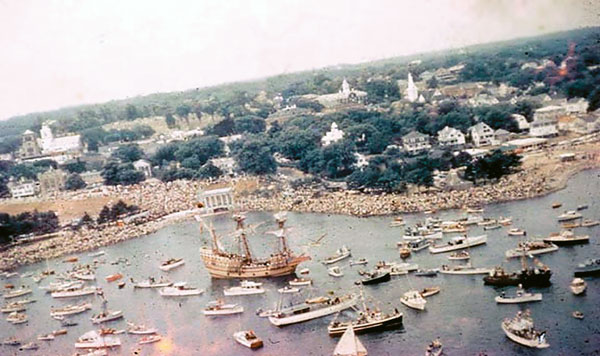
PLIMOTH PLANTATION
In 1957, she completed her transatlantic retracing of the Pilgrim voyage of 1620, arriving by sea at Plymouth, Massachusetts, to great fanfare. The restored ship will sail into the port once again in May 2020, ready for many more years of service.
And then the routine maintenance began.
MAYFLOWER II stands as an example of a ship reconstruction that had a clear purpose and stuck to it. Many other “tall ship” projects have started in bursts of creative energy, but after the tumultuous welcomes ended the horns no longer blew, the headlines faded, and some struggled to simply survive. Failure was hardly unknown. Columbus ships were broken up in Texas; ships were put on the auction block. But in the center of town at Plymouth’s Pilgrim Memorial State Park, 3 miles from the Plimoth Plantation museum, MAYFLOWER II remained a star—more than 25 million people have crossed her decks since 1957. Nevertheless, even with rare and low-risk sailing, routine maintenance, and such things as daily saltwater wash-downs, she was showing her age, as any ship would. In 2013, she failed a routine U.S. Coast Guard drydock inspection for her continued certification as a “subchapter T” passenger vessel.
“That’s when Plimoth Plantation realized, it’s time for us to take a really deep look at what the ship’s needs are,” said Whit Perry, a veteran boatbuilder and tall-ship skipper who was hired in 2014 as MAYFLOWER II’s captain and director of Plimoth’s marine department.
With the 400th anniversary of the Pilgrim voyage looming on the horizon, Plimoth Plantation took the ship to Mystic Seaport Museum’s Henry B. duPont Preservation Shipyard for what became far and away the most thorough work she has ever undergone. She has been almost completely rebuilt over the course of three years. Some 70 percent of her original hull material has been replaced and her rigging and sails all renewed and redone. The project cost was $11.2 million, a sum that also included an endowment for future maintenance, which will involve Mystic Seaport’s shipyard regularly, and the restoration of an associated shallop built by Plymouth (Massachusetts) Marine Railway in 1957 (see sidebar, page 70).
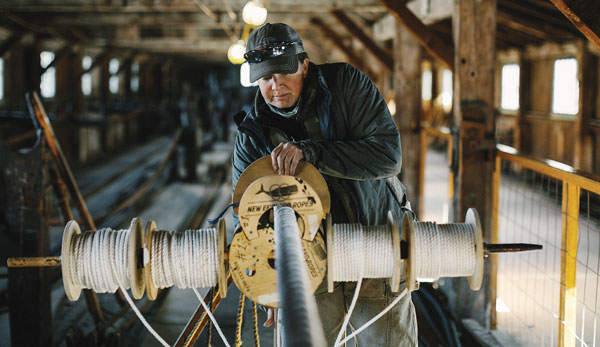
PLIMOTH PLANTATION
For the tedious work of worming, parceling, and serving the standing rigging, the Mystic Seaport riggers set up shop in the museum’s 250’-long ropewalk building. The 1824 building, which housed the Plymouth Cordage Company until 1947, was dismantled in 1951 and rebuilt, at about a third of its original length, at the museum. Here, a device made by Matthew Otto, and used here by rigger Sarah Clement, handles four strands of worming for a main shroud, with each of its four left-laid strands made up of right-laid Mystic Three Strand. (See a video of the operation at www.bit.ly/WORMING.)
The ship was relaunched in September 2019. Over the winter, her ballasting, interior fitout, and rigging were completed. This spring, in her 63rd year, she will leave Mystic for another triumphant return under sail to the Plymouth town waterfront. En route, she’ll make other stops in Massachusetts, including one in Boston that will involve a day of sailing in company with the 1797 frigate USS CONSTITUTION.
An irony of her restoration is that MAYFLOWER II today is considered a historic artifact in her own right. Baker wrote of knowingly diverging from his rigorous research to deal with the realities of visitor comfort for an “attraction vessel,” one that was built to American Bureau of Shipping standards to be insurable. He gave the ’tween-decks headroom that the Pilgrims would have found luxurious. A quarterdeck grating, he wrote, was decked-over in the early 1960s “in consideration for the high heels of lady visitors.” In this and many other ways, the ship tells of how the world has changed since the 1950s—most important, how the world of replica ships has changed. She is, in some ways, leading the way once more. She is, by all accounts, in better-than-original condition.
“We are fully aware,” Perry said, “that some things have come to light since William Avery Baker designed the ship. We didn’t have VASA yet, we didn’t have MARY ROSE yet.” Both of those renowned wrecks were recovered by nautical archaeologists long after MAYFLOWER II was conceived; the Swedish VASA of 1628 was found at the bottom of Stockholm Harbor the year MAYFLOWER II was launched and was finally raised four years later, in 1961; the English MARY ROSE of 1511 was raised from The Solent in 1982. Both are spectacular royal warships beautifully researched and exhibited; however, archaeological remains of humble and common merchant ships of their period remain extremely rare and elusive. Anyone researching paintings, drawings, and rare archival records of such ships would be treading ground already well plowed by Baker and his predecessors.
“Incredibly important to me,” Perry said, “and to us as stewards of this vessel, is, No. 1, bringing forward MAYFLOWER II as historic in its own right, and trying, in the restoration, to stay true to Baker’s vision and what the intention of this ship was.” She has been approved as a candidate for the National Register of Historic Places and could one day achieve historic-landmark status, not for bringing Pilgrims to North American shores but for telling their story in such a novel way, as she was intended to do. Perry has also had the practicalities of safety and longevity in mind for every aspect of the restoration. Fresh from the restoration of its own 1841 whaleship CHARLES W. MORGAN, the Mystic Seaport shipyard seemed a logical place to take on the work.
“In order to continue,” said shipyard manager Quentin Snediker, “she needed this kind of significant work. People argue that we should have just built a new one. But we’ve tried to treat it just like we treated the MORGAN, as historic in its own right.”
Many among the shipyard crew that worked on MAYFLOWER II were veterans of the MORGAN reconstruction (see WB No. 226), and from Snediker’s perspective one essential reason for working on the Plimoth ship was to hold his crew together and maintain their expertise in handling large timbers and double-sawn frame construction—skills that also will be essential in the upcoming extensive reconstruction of Mystic Seaport’s 1921 Banks schooner L.A. DUNTON. That project is expected to start in 2022, and in January of this year, as the MAYFLOWER II’s carpentry work was winding down, the first 40 white pine logs acquired for the DUNTON project were delivered to the yard. “It enabled us to keep the momentum of the MORGAN rolling, both in terms of labor and access to materials,” Snediker said, and that momentum will roll into the next project.
Plus, the work took place in a museum setting. “It’s absolutely fabulous in terms of a collaboration,” Snediker said, “because Plimoth is an outdoor history museum, so much like what we are.” Even though the ship wasn’t at home in Plymouth, it was in public view throughout the work, and more than 250,000 people visited while she was in the shipyard.
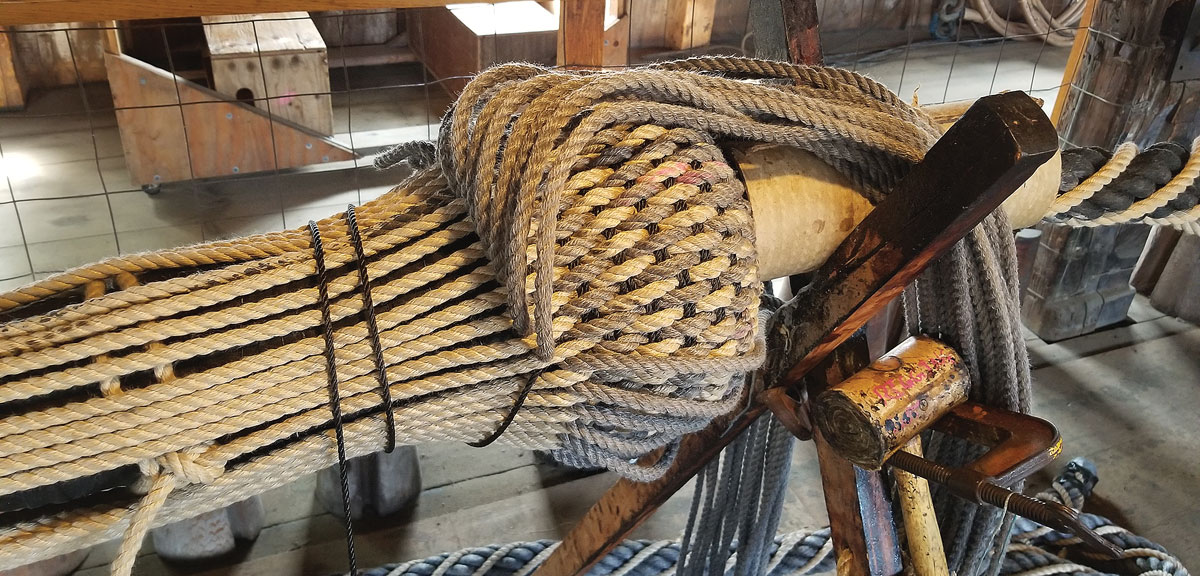
PLIMOTH PLANTATION
A “raised mouse,” a kind of built-up lump near the end of a stay that serves as a stopper knot against which an eye bears, is common in rigging traditions from before the age of galvanized wire. This one is for MAYFLOWER II’s mainstay. Long-lasting synthetic rope emulates the qualities of hemp cordage and allows such traditions to continue.
Arguably the most dramatic change in the ship—and perhaps the greatest shift in the story it retells in the beginning of the 21st century—is found in its rigging. When the ship was launched, she carried Italian hemp that Villiers called “wholly faultless and magnificent” and flax sailcloth he called “splendid stuff” woven in Scotland. Such qualities of hemp and canvas were rare even in the 1950s. At that time, MAYFLOWER II was something new: a ship built as authentically as possible. She was a genuine innovation in what later became known as experiential archaeology, the impetus to expand research by building something to find out how it works by using it.
But as her original materials deteriorated naturally over the decades, alternatives crept in. In the rigging, as blocks failed others of close-enough fit were substituted. Shrouds and footropes were replaced with safer, but anachronistic, 1″ galvanized wire, hidden under worming, parceling, and serving. Various types of synthetic cordage replaced hemp, which had become all but nonexistent in quality that anyone could describe as “magnificent” or “splendid.”
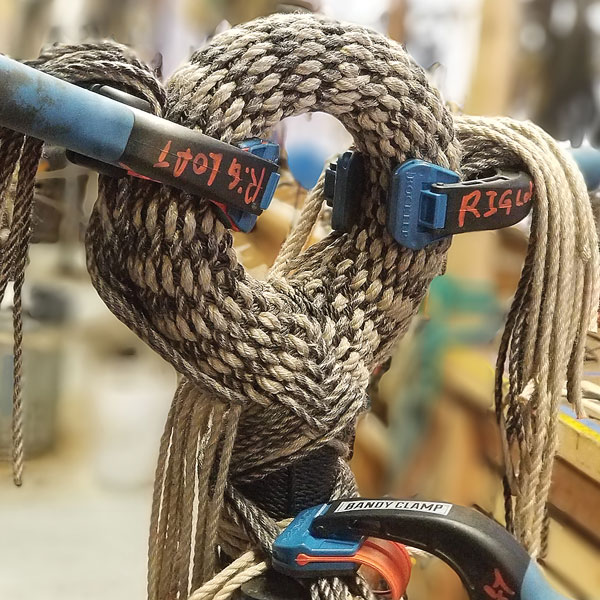
PLIMOTH PLANTATION
This tightly made “spindle eye,” this one at the upper end of the mizzenstay, allows the rope to pass through, and then the eye bears against the raised mouse. The resulting loop passes around the masthead.
Ironically, what allows the most traditional marlinespike seamanship of the ship’s Elizabethan heritage to survive today is the thoroughly modern technology of synthetic rope.
Matthew Otto, head rigger at Mystic Seaport, took the ship back to as close to her original rigging specifications as he could. He came to the project with broad experience not only with rigging Mystic Seaport’s ships but other reconstructions of 16th- and 17th-century vessels—England’s GOLDEN HINDE, Delaware’s KALMAR NYCKEL, and Columbus 500th anniversary ship reconstructions of the late 1980s among them. He also has broad experience with both modern and traditional rigging techniques and materials. Otto worked with New England Ropes of Fall River, Massachusetts, to develop a new cordage, which the company now calls Mystic Three Strand, which was used extensively for MAYFLOWER II’s standing rigging.
“What people don’t realize is that hemp is a very low-stretch material,” Otto said, “Hemp has a similar stretch coefficient to Kevlar, and Dyneema is also in that group. If you’ve ever dealt with hemp much, you know when you load up hemp, and really load it up, even a new fresh piece that’s just got light tar in it, if you take the load off it, it’s stiff for a few minutes and then it eases back and you can untie it. The Mystic Three Strand behaves exactly like that, which is a wonderful thing for all of us, because that’s what we’re trying to make, something that is a good analog for hemp.” Natural hemp rope available these days is often made with inferior hemp fiber, often blended heavily with flax, which harms its handling characteristics and its longevity. Most sailors who disdain hemp today have probably never actually held authentic hemp rope in their hands.
In some earlier versions of hemp look-alike cordage, Otto said, high-tech cores such as Kevlar were combined with softer outer sheathings. “Dealing with the Columbus ships, we actually had a four-strand manila with a Kevlar core, and by the time we got done putting the ratlines on the first set of shrouds, the manila had sloughed down like baggy socks around your ankles. I had seen other boats that had done similar things with very low-stretch cores, and it does exactly the same thing, because you end up with stuff that has dissimilar stretches.”
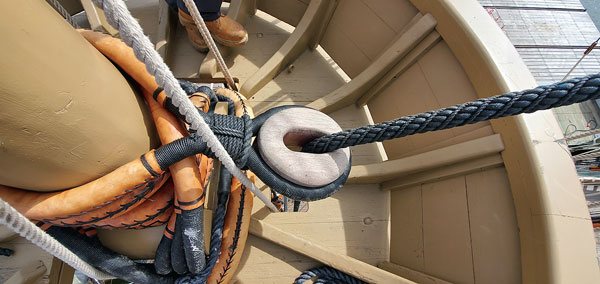
MATTHEW OTTO
In her main top, MAYFLOWER II shows how little metal is used in her rigging, for which cordage is the foundational technology.
In the Mystic Three Strand, Dyneema fibers are intermixed with softer polyester fibers within each of the three strands—“So the polyester isn’t ever really stretching out, it’s riding on the SK78 Dyneema, so you don’t end up with it stretching and doing funky stuff. With a piece of polyester, when you stretch it up for serving, over 100′ we’d get probably 20″ of stretch—with Mystic Three Strand, we only get 5″,” Otto said.
The end result is that the ship’s wire shrouds and stays could be replaced entirely with something much closer to the traditional cordage not only in appearance, but, more important, in function. “This stuff splices like a cloud full of butter; it’s very nice material to work with,” Otto said. The rope has very little stretch, weathers very well when painted to resist ultraviolet light, and is very strong—New England Ropes’ tests, Otto said, showed a 1″ rope breaking at 40,000 lbs of load. In the sizes that match the aesthetic requirements of a historic ship, that capacity is far beyond any technical load requirements.
The cordage is also a great deal lighter than the rigging the ship carried when she came to Mystic Seaport. Perry estimates that the ship’s total weight aloft has been reduced by a third. Some components are half as heavy as before: the new mizzenstay, Otto said, weighed 60 lbs including its deadeye compared to 115 lbs, without the deadeye, for the one it replaced. Lighter weight aloft, combined with more effective ballasting, means that the ship will be more stable, opening the prospect that she could sail more frequently, and more safely, than in previous decades.
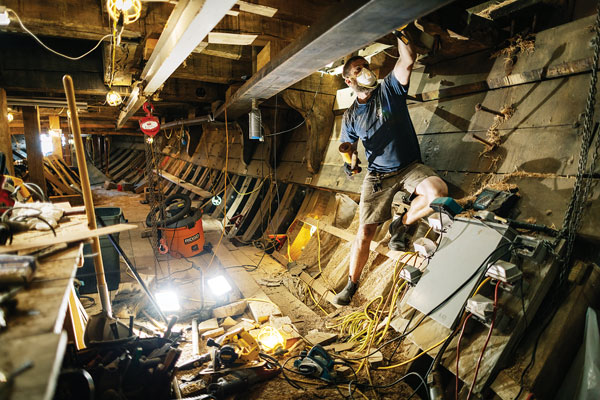
PLIMOTH PLANTATION
When the ceiling and exterior planking started coming off during the early part of the restoration, the rot in the framing and structure was worse than expected. The replacement materials—especially live oak for frames and knees, North American white oak for deckbeams, and Danish oak for planking—were of extraordinary quality.
Much of the work on the rigging was done in public view at the Mystic Seaport Museum’s ropewalk building, which originally housed the Plymouth Cordage Company and was moved to the museum in its early years. For decades, the ropewalk was a static display, but in recent years it has been used to lay up rigging first for the MORGAN project and most recently for MAYFLOWER II.
All of the new lower shrouds on MAYFLOWER II are of shroud-laid, four-strand rope with each strand made up of smaller-diameter Mystic Three Strand. The mainstay and forestay are 3″ cables of the same material. The standing rigging is painted with black polyurethane, which has to be regularly refreshed. It looks a bit like a tar coating but without the traditional rich scent of pine tar, which Otto said would never adhere to the synthetic fibers. All of the running rigging, varying from 5/16″ to 11/2″ in diameter, is of a readily available New England Ropes cordage called Vintage Three Strand, a blend of spun and filament polyester.
In a way, the technology of Elizabethan-era ships is all about the science of rope. “It is amazing to me,” Perry said, “to think that in the early 17th century, with just the hundreds of blocks and rope, what a high-tech machine this really was. This was state-of-the-art in 1620. For the 102 passengers that came over in 66 days, it would have been like you or I going to the moon.” The only metal in the rigging is a few hooks here and there and chains securing the lower shroud deadeyes.
The blocks in MAYFLOWER II’s rigging are almost all fairly simple—mostly singles, often used in combination with other singles but with a smattering of fiddleheads and doubles. About half of the blocks were found to be sound and were returned to service. R.J. Lavallee of West Hartford, Connecticut, worked with a volunteer crew from both Mystic Seaport and Plimoth Plantation to recondition those and also to make 100 replacement ones. Some blocks had been repurposed, to the point that “complete systems had been kind of pushed aside due to attrition,” Otto said. He coordinated the restoration of the rigging to the original plans using appropriate blocks matching the size of cordage used.
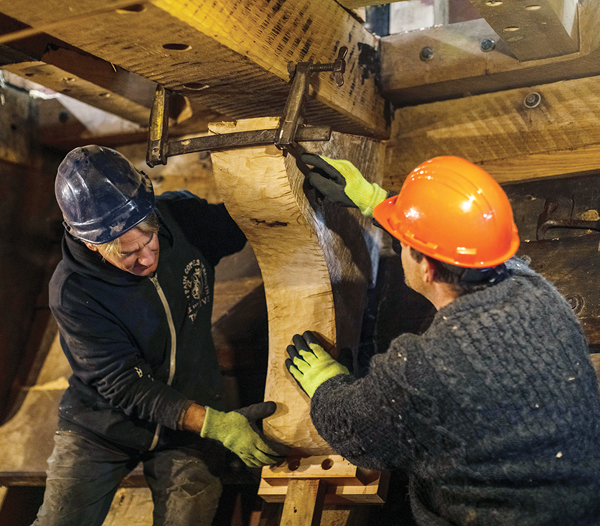
PLIMOTH PLANTATION
More than 50 knees in the hold had to be replaced, using grown live oak timbers 4½″ thick.
Perry believes that having the ship sail regularly, and fully documenting the work done, will keep the crew’s focus on maintaining the rigging as a functional machine. “Certainly the main mission of the ship is education and public awareness of history at the dock as an attraction vessel,” he said, “but I certainly hope—if I can have anything to do with it and get our board to agree—that certainly now is the time to get underway a little bit more than we have in the past.” Sailing the ship is one way to assure that those systems are understood and remain intact.
“The techniques need to survive,” Otto said. “It certainly keeps the history alive, doing it with period techniques. The value is so that we don’t lose the ability to do it. We won’t have to stop and relearn everything that came before.”
Passing along such skills is also important. With Plimoth’s eye toward continuity, one of Otto’s rigging apprentices for MAYFLOWER II was Don Heminitz, a Plimoth Plantation employee. He started as a living-history interpreter, dressing in period costumes and staying in character while explaining the colony’s history (which for years now has extended equally to Native American perspectives). “I started in the English village,” Heminitz said, “but I came to the ship, and I fell in love with it.”
Heminitz has worked with Perry in the museum’s marine department for six years, mainly on rigging. “I had no idea that this was something I’d be interested in until I started getting into it. It’s been a number of years since we’ve had all of her rig up, but seeing all the sailing gear that we haven’t used since 2014, and understanding the fact that it is just a machine, that everything works together, it’s really interesting once you can kind of see that, versus just a bunch of lines in a spiderweb. It’s one of the reasons that we wanted to come here, because of that ability to work right alongside the people who are doing the restoration, so we can build our skills and learn to properly maintain this for the next generations.” When the ship sails into Plymouth, Heminitz will be aboard as a bosun.
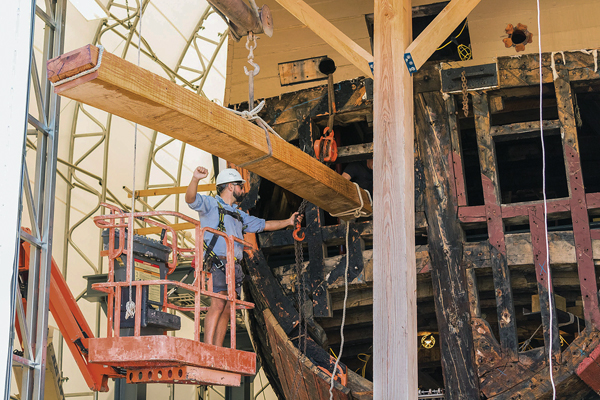
PLIMOTH PLANTATION
For MAYFLOWER II, which has become a historic vessel in her own right, the reconstruction blended the desire to match original materials as closely as possible and an imperative for longevity and safety. The reconstruction will allow her to regain her certification as a U.S. Coast Guard–inspected passenger-carrying vessel.
Her new sails were made by two lofts, Traditional Rigging Co. of Appleton, Maine, and Evolution Sails Chesapeake in Deltaville, Virginia, using Oceanus sailcloth, the canvas look-alike made of polyester and developed in a collaborative effort of North Cloth and sailmaker Nathaniel Wilson of East Boothbay, Maine. With all that new canvas set and drawing, the purpose of all that rigging will become as clear as it ever was or ever will be.
In her hull reconstruction, MAYFLOWER II is retelling another story: the unfolding technology of historic ship construction and restoration in the modern era. Unlike her rigging, her hull contains very few conceptual changes from the original construction—but she reflects the increasing degree of care that is lavished on ships, with extraordinary materials and with skills that have been passed down, and perfected, through generations of museum shipwrights.
It was no surprise to anyone that the ship would need work. In a way, it was a surprise how long she lasted. Original ships of the period she represents had lifespans of perhaps 20 years. Many a modern replica ship has both come and gone since MAYFLOWER II reached her destination in 1957. Maintaining that longevity, together with safety, were imperatives for Plimoth Plantation, Perry said. He and Snediker both worked to find superior woods: live oak from the American South for her frames; white oak from the Eastern states for upper futtocks and topside planking; and Danish oak, the same Quercus robur species of her original English oak, for her lower hull planking. The quality of the wood, particularly the Danish oak—flawless lumber 24″ wide, 3″ thick, and sometimes 40′ long—has been staggering even to veteran shipwrights.
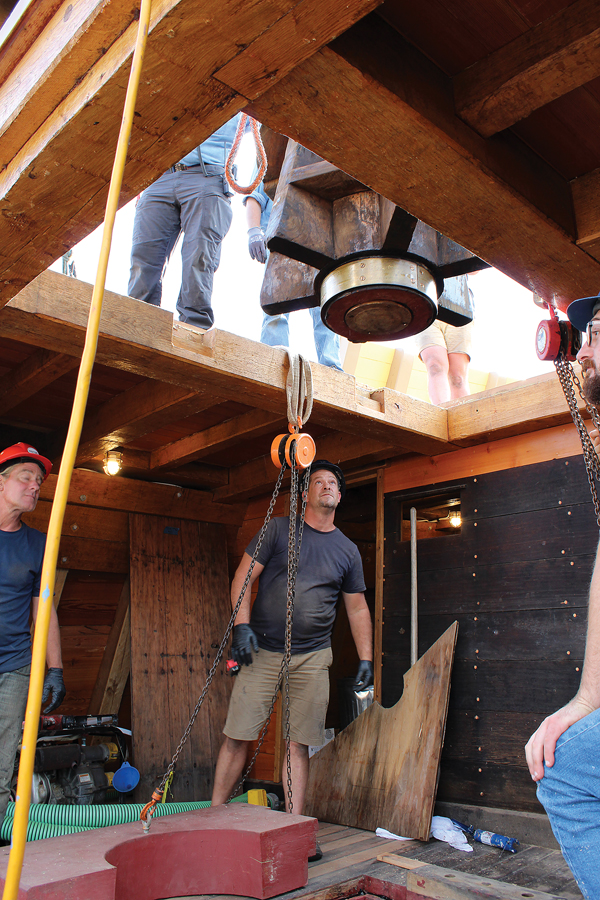
PLIMOTH PLANTATION
Some prominent original pieces—such as the English elm capstan seen here being lowered into position—were restored rather than replaced. The capstan’s wood is largely original, but it rotates on new bronze bushings. The elm handspike windlass (visible in the photo on page 66) was also reconditioned and reinforced with replacement knee braces and bronze strapping.
“She was probably in worse condition than we anticipated,” Snediker said. “When she came back the third winter, we laid into her, and after we opened her up we did find deterioration in a lot of places we hadn’t anticipated. Deckbeams, in particular, needed more work—and more of the knees, both lodging and hanging—than we anticipated. We tried to take the view that she’d last another 60 years in the work we did. There was some stuff that was probably marginal for the next 10, but it was so deeply buried in other structure that it was most efficient to do it all at once. Anybody who’s ever done a boat project knows about that.”
For the shipwrights, the wood has been a marvel to work with. “The planks, there’s hardly a knot in them—maybe none,” said Trevor Allen, a veteran of the MORGAN restoration who spent two years on MAYFLOWER II’s replanking. “The materials that have gone into this restoration are unbelievable in their quality,” Perry said. He also attributes the ship’s longevity to excellent materials used in the original construction in a very different era. Considerable work was done on her over the years, mostly above the waterline, but the work at Mystic Seaport is by far the most intensive ever undertaken for her.
The experience that Allen gained by working with double-sawn frame construction on the MORGAN restoration prepared him, and many others, for the MAYFLOWER II project. “The construction is similar, and the scantlings were close,” he said. As with the MORGAN, the crudeness of the original frame construction proved surprising. “A lot of the framing was pretty rough,” Allen observed—perhaps a function of the time pressures in a commercial shipyard. “No doubt they were on a timeline, but I was surprised at how blown-apart the lumber was on the boat. Like all of it. We ended up replacing practically every piece of wood on the boat.” The use of the best materials available today was paired with the expectation of tight fits and painstaking work. Modern yards, with regular U.S. Coast Guard inspections of replica ships, work to more rarefied expectations than their predecessors.
Allen is a 13-year veteran Mystic Seaport shipwright, but new employees pick up on the yard’s traditions. Chris Sanders started a year a half ago amid the MAYFLOWER II project, after graduating from the International Yacht Restoration School in Newport, Rhode Island, and working in California for several years. “I was originally given the task to replace the stem,” he said, “and we soon realized that even if we put the stem back together, there wasn’t going to be much to attach it to. What started out as a stem replacement ended up being a ‘replace the forward fifth of the boat’ sort of job,” including all four breasthooks and beam shelves.
“You don’t get to do this kind of stuff on this scale very often,” Sanders said. “Just for example, the stem has five major components, three pieces to the outer stem and two big pieces to the apron. I think the smallest one weighed something like 1,800 lbs—big pieces, 14′ or 15′ pieces of live oak that had to fit together like a glove.” Perry and Snediker both worked their extensive contacts to find such materials.
Even then, difficulties arose. When the enormous stem knee clearly needed replacement, Perry said, three live oak candidates earmarked for the piece proved too flawed for use once they were sawn open. One of the few laminated hull pieces used in the restoration is an enormous stem knee made of sapele; another prime example of lamination was a new resorcinol-glued Douglas-fir mainmast, which promises to last longer than a solid timber mast.
Sanders next went to work with a crew replacing knees. “I think there were 64 knees in the hold, and we ended up replacing 51 of them,” he said. Perry noted that the knees had been iron-fastened in the original construction, and he believes that corroding ferrous fastenings caused them to blow apart from the inside as rusting caused the fastenings to expand. Sanders, too, pointed out that frame deterioration could be traced to ferrous fastenings: “The extent of the deterioration started to rear its ugly head when we started pulling out decking and planks—frames that looked okay from the inside, you’d pull the planking off the outside and they were hollow from the fastening sickness. The extent of it was much greater than we’d feared.” So, in the knee replacements, custom bronze-rod rivets were used instead. Bronze was also used to fasten the topside planking, using No. 20, 4″ screws. Below the waterline, the ship was originally fastened with a combination of wooden trunnels and 8″ galvanized spikes; to follow original construction as much as possible and to avoid the corrosive effects of using dissimilar metals underwater, the yard followed suit below the waterline. By using similar—or better—materials with perhaps more refined construction techniques and, where practical, better fastenings, the ship looks much as it did when new.
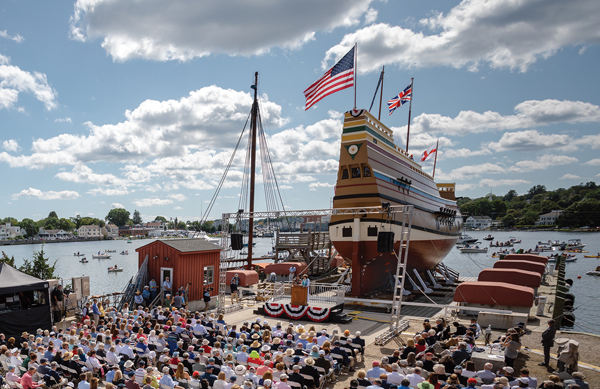
PLIMOTH PLANTATION
After her relaunching in September 2019, MAYFLOWER II’s restoration and rigging were finished alongside the dock at Mystic Seaport. She is scheduled to return to Plymouth, Massachusetts, in 2020, stopping first in Boston to, among other things, sail for a day in company with the historic U.S. Navy frigate USS CONSTITUTION.
By February 2020, the carpentry work was down to the last details, and one of Allen’s projects was building companionways with aluminum treads, again for longevity in areas of high wear under the heels—high or not—of countless visitors expected during the Plimoth Plantation 400th anniversary year and decades beyond. “At first I was kind of bummed-out,” Allen said, “that we were going to be putting in these aluminum treads and stainless-steel hardware, but then I’ve kind of come to the realization that because these things don’t belong on the ship, I think it makes sense to me that they don’t look like they’re supposed to belong on the ship. I’ve come around to that.” The stainless railings on the dual companionways from the waist deck down to the ’tween deck are also meant to be easily removable so that the hatchway can be efficiently covered to keep rain and condensation out after closing hours.
Wherever possible, original material was saved. The keel and some futtocks are original. The English elm handspike windlass is original, but reinforced with new bronze strapping and several new bracing knees. The elm capstan, too, is original, but fitted with new bronze bearings. New bulkhead planks alongside old, weathered ones show clearly what material was replaced.
Another important change belowdecks will help to balance MAYFLOWER II’s new rig. When she was built, Perry said, the ship was ballasted with 130 long tons of mostly old iron railway rails and concrete—hardly an authentic Elizabethan feature. That was all jackhammered out and carted away—about four tons of it in the form of rusty sludge—and replaced with 127 long tons of lead, keeping the ballast more compact and therefore lower in the hull. The lead is in the hold, an area not open to the public. It is restrained by slatted bulkheads under a deck sole, also slatted, that will allow ample ventilation.
Right under the sole are bronze screens intended to catch debris before it can pass into the bilges. The sole can be raised in sections for easy access when cleaning the screens. New concrete was poured in the frame bays, primarily to prevent standing water at the frame heels and secondarily to guide leakage to the ’amidships bilge sump. Fresh water that makes its way to the ’tween deck—mostly from rainfall—drains into modern flexible hoses, out of sight of the public, that direct the water to a series of salt boxes built within frame bays. Any fresh water will thus be salt-brined before making its way to the bilges, and the salt boxes have hinged lids to allow their rock salt to be replenished.
Also out of public view in the hold is a new holding tank and a commodious engineering room, with an AC generator and an alternative battery bank for running silent on DC power when desired. The ship has never had an engine. The electrical system powers conventional lights and automated emergency lights, plus up-to-date communication and navigation devices, including a 15″ touch-screen Garmin chart plotter with integrated vessel traffic monitoring. The navigation station, set up in the small cabin that Villiers called home for the transatlantic passage, will give interpreters a chance to compare modern devices not only with the technologies of the backstaff, log line, and transit board of the Elizabethan seamen but also with the analog compass and sextant that were state-of-the-art in 1957.
MAYFLOWER II will go on telling the story of Pilgrims and European first contacts with the people of the New World, but the ship will also retell of the survival of traditional rigging techniques, of how the oldest shipbuilding skills live on into another century, about people who found adventure at sea, about people who devoted their intellects and their lives to their own retelling of the story of seafaring. In the legions of the young who trod her decks on school field trips or family vacations are those who will hear that story anew. And it will fall to them to tell it again. 
Tom Jackson is WoodenBoat’s senior editor.
And a restored shallop, too
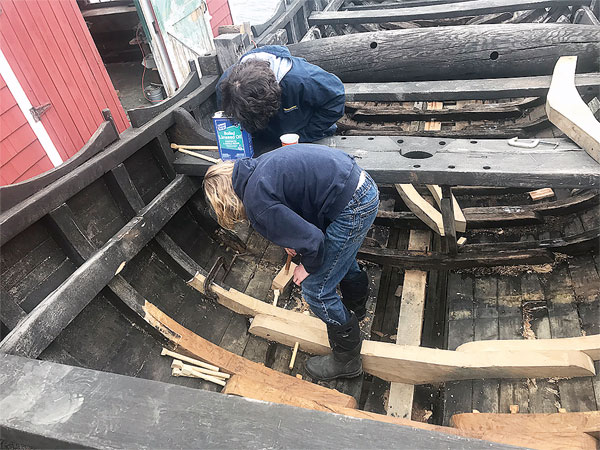
PLIMOTH PLANTATION
At Lowell’s Boat Shop in Amesbury, Massachusetts, a 33′3″-LOA shallop built in 1957, has also been restored. The project involved replacing almost everything below the waterline.
At the same time that the MAYFLOWER II restoration was nearing completion, the restoration of the ship’s shallop was also coming to the conclusion of an extensive reconstruction. The boat, 33′3″ LOA with a 9′2″ beam and a 3′3″ depth amidships, was designed by William Avery Baker and built in Massachusetts at Plymouth Marine Railways as a conjectural reconstruction of the boat the Pilgrims brought to the new world “in frame” in the hold of their ship.
The 1957 boat sailed out to greet MAYFLOWER II when she arrived in Plymouth, with Pilgrim descendants at the oars to row Alan Villiers and the crew ashore. She was being rebuilt at Lowell’s Boat Shop in Amesbury, Massachusetts, for an April relaunching, and she’ll sail in May to rejoin MAYFLOWER II once more at Boston for the sail to Plymouth. Graham McKay, Lowell’s executive director, worked on the project with Mike Brittan, formerly of the Mystic Seaport staff as a MAYFLOWER II shipwright, and Jeff Lane, in conjunction with a cadre of high-school student apprentices.
The lower half of the hull has essentially been replaced. She has a new keel and keelson, both of longleaf pine replacing her original white oak ones. Her new floor timbers and lower single-sawn overlapping or half-lapped frame futtocks are of live oak, replacing white oak. Her knees and sternpost are of white oak. Eight of her lowest strakes are being replanked in white oak, replacing the original cedar.
“Most of the planking was in reasonably good shape,” Brittan said, except that the caulking bevels were badly damaged over the years. “The frames are where a lot of the deterioration was. I think that’s mostly fresh water traveling on the inside of the frame, behind the planking,” allowing rot to gain a foothold. “Where you’d pull off some of the planking, the outside face of the frames would just sort of crumble away in your hands.”
The boat will also have a new sole, a new mast partner, and new oars built by students. The mast, flax sail, and rigging will be the same.
The planking will fair down to a thickness of 1⅛″, perhaps a bit thicker in the lowest planks. “We’re leaving everything above, for one because it’s in relatively decent shape, but also, when all back together it’ll look like an old boat again,” McKay said. “We’re doing this with the idea in mind that at some point the top half’s going to have to be done in the next 20 years or so, but you’ll have a good lower half to work from.”
One important variation from the original is that the boat will have a discreetly installed Torqeedo pod-drive electric motor. Whit Perry, director of the Plimoth Plantation marine department and MAYFLOWER II’s captain, said that the shallop often has to navigate dense mooring fields in Plymouth Harbor, with a dipping-lug rig that can demand ample sea room for maneuvering. Electric propulsion will give the boat a margin of safety, and it will run in silence. —TJ
